Home » Articles » Trends in Renewable Energy
Trends in Renewable Energy Production and Consumption in the USA
Article by: Hobart M. King, PhD
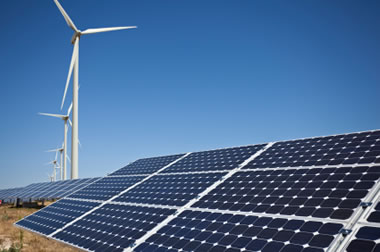
Renewable energy sources: Renewable sources of energy can be utilized without reducing the quantity that can be produced in the future. Wind and solar energy are examples of renewable energy sources. Image copyright iStockphoto / Fernando Alonso Herrero.
Introduction
"Renewable energy" is energy produced from a source that is not permanently depleted. Sunlight, wind, flowing water, geothermal heat, and plants are examples of renewable energy resources. They can be produced today without damaging their ability to be produced in the future.
Over the past decade the use of renewable energy is becoming more important to people, industry, and governments. Why? Renewable energy resources are not depleted, they are becoming less expensive, and they have a softer environmental impact.
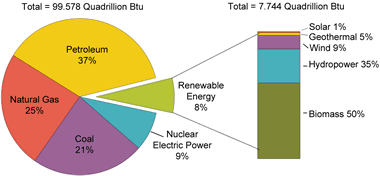
Renewable energy statistics: In 2009, renewable energy accounted for about eight percent of United States energy production/consumption. Of that amount solar, geothermal, wind, hydropower, and biomass each accounted for at least 1% of the total. Source: Energy Information Administration.
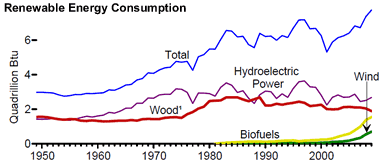
Renewable energy consumption: Trends in renewable energy production/consumption from 1950 through 2009. The quantity of energy produced from renewable sources has increased steadily over time. Most significant is the rapid growth in biofuels and wind during the past decade. Source: Energy Information Administration.
Historical Use of Renewable Energy in the USA
Two important sources of renewable energy in the United States have always been wood and water power. Animal power might also be considered an important early source of renewable energy. These accounted for almost all of the energy produced in the United States until coal mining began in the mid-1700s and drilling for oil and gas began in the mid-1800s.
Once the production of fossil fuels became commercialized, wood and water were gradually replaced as primary fuels. It became less expensive and more convenient to supply the energy needs of a home or a factory from fossil fuels than from wood or water. Fossil fuels became the new primary fuels. Today - over 100 years later - they are still in that dominant position.

Renewable energy consumption by sector: Trends in renewable energy production/consumption by sector from 1950 through 2009. Renewable energy use in the electric power and industrial sectors has been growing steadily. An explosion in the transportation sector has occurred in the past decade. Source: Energy Information Administration.
| Wind Energy Potential Map |
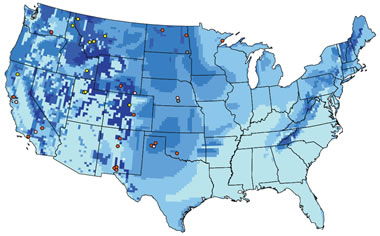
The United States Environmental Protection Agency has prepared this utility scale wind energy generation potential map. Darkest blue areas have a watts/square meter potential of over 800. Image EPA.
| Solar Energy Potential Map |
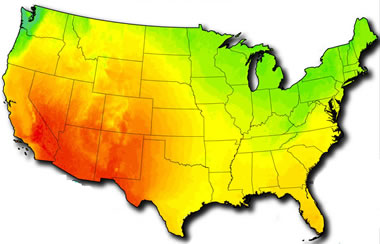
Solar energy potential map: The National Renewable Energy Laboratory has published a number of solar energy potential maps. The southwestern United States has the greatest potential for solar energy projects. More detailed information.
A Slight Awakening for Renewable Energy
Fossil fuels allowed the industrialization of the United States, but their use was mainly clustered around mines and wells until efficient transportation methods were developed. In areas away from coal, oil, and gas deposits, water, wood and sometimes wind continued to power the nation.
Since about 1970 renewable energy sources have provided only about 5% to 7% of the power consumption in the United States. However, in the past ten years renewable energy has received greater attention. The reasons for this increased attention include:
Higher Fossil Fuel Energy Prices
The prices of oil, natural gas and coal have been rising steadily, and the fossil fuel prices can be volatile and unpredictable. Although renewable energy has historically been more expensive, the cost differential decreases as prices for fossil fuels rise.
Fossil Fuel Resources are Being Depleted
When coal mining began in the mid-1700s, the coal seams close to the surface were the first to be exploited. Over time the easiest to mine and highest quality coals were quickly mined out. What remains today is usually more challenging to mine or has a lower quality.
Exploration for oil and gas quickly found the largest, shallowest deposits. Today the exploration targets are often smaller, deeper and located in difficult environments such as the deep ocean or the Arctic.
Climate Change
Fossil fuels such as oil, natural gas and coal are rich deposits of carbon buried deep in the Earth. They accumulated there slowly over hundreds of millions of years.
When fossil fuels are burned, their carbon is returned to the atmosphere in the form of carbon dioxide - a greenhouse gas that contributes to global warming and climate change. In about two hundred years, humans have produced and burned a significant portion of Earth's fossil fuel resource, sending it into the atmosphere nearly a million times faster than it was removed to form fossil fuels.
Government Support for Renewable Energy
Today, governments worldwide accept the fact that burning fossil fuels is rapidly modifying Earth's atmosphere, leading to climate change that has many undesirable impacts. In an effort to slow the release of carbon dioxide into the environment, governments are offering grants, tax incentives, and other programs designed to support renewable energy development.
Technology Improvements and Lower Costs
While fossil fuel prices are rising, the cost of manufacturing solar panels, geothermal systems, wind turbines and other renewable energy equipment is falling on a cost-per-BTU basis. While the cost of renewable energy still remains high, the price trend is in a favorable direction. This is when government support can make a big difference.
Commercialization and Infrastructure
As more renewable energy projects are completed, their ability to integrate smoothly with buildings, vehicles and primary energy sources is improving. Mass production brings down prices, and a growing adoption rate increases availability of reliable equipment, parts and service expertise.
While all of the above suggest we are on the edge of a renewable energy explosion, we have still not crossed important price points and market penetrations to make renewable energy self-starting and self-sustaining. This is why governments are attempting to support the adoption and improvement of renewable energy systems.
Renewable Energy | ||
| Source | Percent Growth 1995 - 2009 | Percent of US Energy Supply in 2009 |
| Hydro | -17.9% | 2.83% |
| Geothermal | 26.9% | 0.39% |
| Solar | 55.7% | 0.12% |
| Wind | 2,012.1% | 0.74% |
| Biomass | 15.9% | 4.12% |
| Total Renewable | 15.9% | 8.20% |
| Data Source: Energy Information Administration | ||
| Geothermal Energy Potential Map |
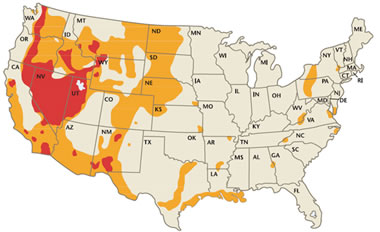
Geothermal Energy Potential Map: The National Geothermal Data System published a geothermal potential map for the United States. It shows that geothermal heat pump installations can be successful throughout the country (light tan), low-temperature direct-use areas (under 100 degrees C) are abundant in the western US (orange), and a few states have potential locations for electric power generation where subsurface water temperatures are over 100 degrees C (red). Not every location shown in these colors will be suitable because of local ground conditions, land use regulations and other factors. More detailed information.
Recent Renewable Energy Trends
Renewable energy currently accounts for about 8.20% of the United States energy consumption. Most of that comes from biomass and hydroelectric sources. Since 1995 the amount of energy produced by renewable sources has increased by 15.9%. If the United States hopes to have 25% of its energy produced from renewable sources by 2025, an enormous push will be needed.
The most rapidly growing renewable energy source since 1995 has been wind power. The implementation of wind power has exploded with an increase of over 2000%. Although this is spectacular growth, wind contributes less than 3/4% of the nation's energy supply.
Solar has grown over 55% since 1995, and the rapid fall in the per-kilowatt price of solar panels should support future growth. Geothermal has grown nearly 27%. New technologies and higher fossil fuel prices now make geothermal space-heating projects cost competitive with fossil fuel units.
| Hydropower Potential Map |
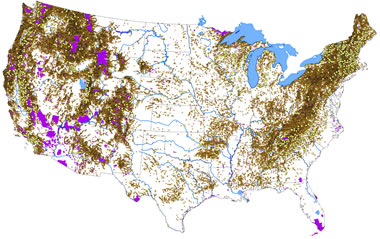
Hydropower energy potential map: The United States Department of Energy has published maps showing the current use and future development potential of hydropower in the United States. Most of the areas are located where streams flow across areas with at least moderate local relief. More detailed information.
Trends for the Future
The future of renewable energy is very bright. The cost per BTU has been falling. Methods of integrating them smoothly into buildings, vehicles and primary energy sources are improving. Climate change fears are motivating governments to support renewable energy projects with grants, tax relief and other incentives.
Renewable energy projects almost always help the United States to become more energy independent. This is because renewable energy projects are usually located close to where the energy will be consumed. This decreases their environmental impact, decreases costs and gives governments incentives to reduce foreign dependency.
Where Will New Renewable Projects Be Sited?
Opportunities for renewable energy projects exist at locations across the United States. Geothermal heat pumps can make economic sense at almost any location in the United States where ground and local development conditions are suitable. The western United States is especially blessed with broad areas with high potential for wind, hydro, solar and geothermal projects (see maps on this page).
The use of renewable energy should grow rapidly over the next decade as their technologies become more efficient and cost-competitive with fossil fuel. Costs, climate protection goals, and ideals of energy independence will help them succeed.
| More Energy |
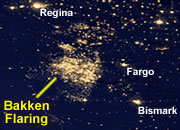 |
Oil from Space at Night |
 |
What is LNG? |
 |
Methane Hydrate |
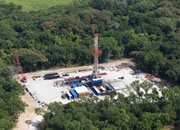 |
Oil and Gas |
 |
Gifts That Rock |
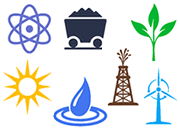 |
History of Energy Use |
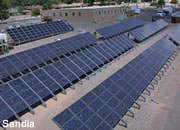 |
Renewable Energy Trends |
 |
Waterproof Paper |

Find Other Topics on Geology.com:

|

| ||

|

| ||

|

| ||

|

|
